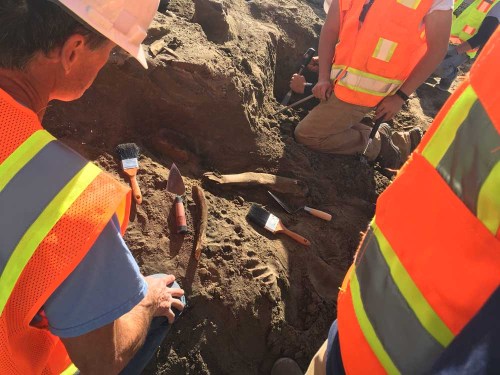Construction crew finds prehistoric bones in Prineville
Published 2:00 pm Friday, November 8, 2019

- Eastern Oregon University microbiology professor Joe Corsini, left, shared his paleontology expertise, assisting anthropology professors Rory Becker and Linda Reed-Jerofke in leading a dig of a prehistoric mammoth or mastodon in mid-October near Prineville.
BEND — The tusk poking out of the earth looked distinctly out of place in the gravel seam where Reid Comstock was maneuvering his excavation digger last March.
“Something looked a little funny in the ground,” said Comstock, an employee of Knife River Corp., a construction materials supplier that specializes in rock, sand, asphalt and concrete. “I grabbed a couple of guys to see what we had discovered.”
Trending
What Comstock found in the 15-foot deep pit near Prineville was the tusk, cranium and other bones belonging to a prehistoric mammoth or mastodon. After relaying news of the find to his three daughters, the family called it “Peaches” after one of the young mammoths in the animated movie “Ice Age.”
Mammoths and mastodons survived on the American mainland until about 10,000 years ago.
Scientists do not have a definitive reason for their extinction, although climatic changes and hunting by prehistoric people are believed to be the two most critical factors.
“I have been doing this work my whole life, and you always believe you might find something. It’s just a once in a lifetime opportunity,” said the 45-year-old Comstock, an operator of heavy digging equipment since the age of 12.
Knife River contacted Craig Woodward, the owner of the sand and gravel field, to report the find.
“It was (Woodward’s) mammoth, and we wanted him to be able to see it as it was found. He was very impressed,” said Tony Spilde, director of communications for Knife River.
Trending
Woodward, a graduate of Eastern Oregon University, contacted his alma mater to assist in the recovery of the specimen. The 72-year-old died just a month after the discovery of the site. Shortly afterward, university faculty visited the area and agreed to conduct an excavation of the partially fossilized bones at a later date. Faculty and students returned in the fall to perform the dig.
“It would have been great if he could have watched the faculty and students from EOU — they were true professionals, and it was great to work with them,” Spilde said.
Following the discovery, the specimen was reburied by the construction workers. Knife River declined to provide a specific location as the site is owned by the Woodward family, and the company wants to prevent people from making unauthorized archaeological searches.
In mid-October, university staff and students returned to the site to extract the partially fossilized bones over the course of four days. The remains were taken back to the EOU campus in La Grande.
Recovered bones include the cranium, a front arm (humerus, ulna, radius) and several vertebrae and ribs, according to Rory Becker, the anthropology and archaeology professor who led the dig.
A portion of the tusks nearest the cranium are still intact, but the tusks in general are in poor condition, said Becker, adding the animal was probably a juvenile, based on the structure of the long bones.
Becker, who in recent years has been part of teams that studied Neanderthal cave sites in Croatia, said it’s not clear why the majority of the bones went missing. Further analysis of the bones and the sediment around them could provide answers, he said.
Other questions, such as what killed the animal and how many years ago it lived, are yet to be determined. Becker believes the research could last three to five years.
The team will try to determine if the animal was a mammoth or a mastodon — the two are distinct animals but remains of both have been found in North America.
Mastodons were shorter and stockier than mammoths, with shorter tusks. Scientists pay particular attention to the teeth — mammoth molars had flat surfaces designed for chewing grass while mastodon molars have pointed cones adapted for munching on leaves, twigs and branches.
Peaches’ mandible and teeth are covered with sediment. The next stage of project will reveal that part of the specimen.
The remains of the animal are expected to go on public view upon completion of the research. No official name has been given yet to the specimen, but Becker said “The Woodward Mammoth” is being considered.
In addition to the science that can be learned from the find, Becker said the project served as an outstanding, real-world project for students, and one that may help a few decide on a career path.
“As is generally the case with doing fieldwork for the first time, some folks really take to it, and for others, once is probably enough,” said Becker, adding the experience could help students make education and career choices.
The partial skeleton is so far the only such specimen discovered at Woodward’s gravel site. Comstock, the excavator who dug up the bones, believes there could be more.
“We have a lot more digging out there so who knows what we’ll find next,” he said. “You never know what the next scoop of the digger will give you.”









